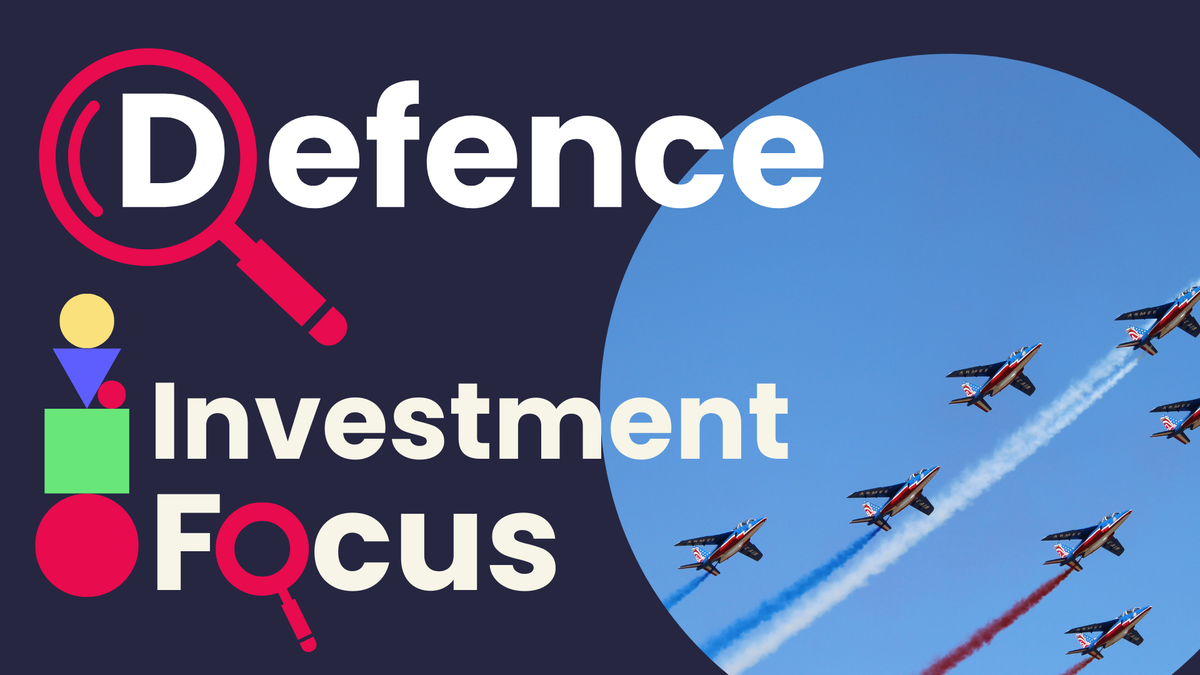Investment Focus: Defence
European defence stocks surge as military spending hits €326 billion
European defence spending is projected to grow by €100 billion by 2027 as geopolitical tensions rise. Discover investment opportunities in defence stocks outperforming the market by 17%, ETF options, and key ESG considerations for defence sector investments.

Defence spending components
Defence spending will usually cover operational costs and long-term investments. It represents a comprehensive measurement encompassing all activities, resources, and investments required to sustain and improve national military capability and security. The UK government is modifying its classification to include security and intelligence agencies, acknowledging the increasing integration of military and intelligence functions in contemporary defence operations.[1]
Standard defence spending categories in the UK, an illustration
Component | Included in defence spending? |
Military personnel salaries | Yes |
Civilian defence staff | Yes |
Military retirement pensions | Yes |
Operations & maintenance | Yes |
Equipment and arms procurement | Yes |
Research & development | Yes |
Military construction | Yes |
Military aid (as donor country) | Yes |
Peacekeeping (if MoD-funded) | Yes |
Veterans' benefits | No |
Civil defence | No |
Demobilisation costs | No |
The end of Europe's peace dividend: Why defence budgets are growing
Since the end of the Cold War, European countries have enjoyed a “peace dividend”. Rather than putting money into military spending, (relatively) harmonious relationships between countries and a quiescent Russia have allowed them to spend money on other areas – social welfare, for example, or education.
However, this peace dividend is evaporating as the world becomes more dangerous. The US and Israel have launched miliary strikes on Iran, while a resolution to the crises in Ukraine and Gaza has proved elusive. The US has made it clear that it no longer wants to be the world’s policeman, and European powers need to pay for their own protection. NATO members have agreed to an increase in defence spending to 3.5% of GDP[11], and may ultimately raise this to 5%.
European defence spending forecast
European defence spending was already rising. Between 2021 and 2024, EU member states’ total defence expenditure rose more than 30% to reach an estimated €326 billion - about 1.9% of EU GDP. To put that in context, the US spends around 3.5% of its GDP, equivalent to over $968bn[2] - on defence spending. This is down from around 5% as recently as 2010.[3] Global defence spending rose to $2.46 trillion in 2024.
Under pressure from the US administration, European countries have committed to raising their defence spending. The UK was among the first to act, with Prime Minister Keir Starmer saying the military spending would increase from 2.3% of GDP to 2.5% by 2027, an additional £6bn. Starmer also set out plans to raise it to 3% in the next parliament.[4] At the recent NATO summit, he pledged to raise it as far as 5% by 2035.[12}
The most significant lift has come from Germany. Historically, it has constrained spending on defence, but under a law enacted in the Bundestag in March, defence and security investment will be exempt from Germany's strict debt rules. The country plans to create an infrastructure fund of €500bn ($547bn; £420bn), of which defence spending will form an important part. The move enabled Germany to release €3bn of aid to Ukraine immediately.[5]
There is also funding at the EU level.
Defence spending across Europe has seen close to a decade of growth reaching €326 billion in 2024 and is projected to increase by at least another €100 billion by 2027. To further strengthen its defence capabilities, the European Commission has unveiled an €800 billion financing plan, including a €150 billion loan instrument targeting key defence technologies. As part of this push, the European Investment Bank (EIB) has expanded lending for defence projects.
Defence stocks outperforming the market: 51% growth in European aerospace
This expansion has drawn the attention of investors. The MSCI World Aerospace and Defense index is up 30.3% over the past 12 months, compared to a rise of just 7.0% for the MSCI World. The gap is even wider for the year to date, with defence stocks up 13.7%, compared to a fall of 6.6% in the MSCI World.
Source: FE FundInfo. Return on £1000 investment across the two indexes May 2024 - May 2025. Hover over the chart to see monthly returns.
European defence contractors have seen even stronger gains, with the assumption that most of the region’s spending will be directed towards local companies. The MSCI Europe Aerospace and Defense index is up 51.8% over the past 12 months, compared to 7.1% for the MSCI Europe.
Source: FE FundInfo. Return on £1000 investment across the two indexes May 2024 - May 2025. Hover over the chart to see monthly returns.
There is also evidence that other manufacturing companies, such as embattled carmakers in Europe, are diverting attention to the defence sector[6].
Military tensions have resulted in a large actual or proposed bout of increased defence spending... BAE Systems and Rolls-Royce have now risen significantly for the year to date. Indeed, Rolls-Royce has seen an additional boost, having implemented a turnaround plan which firmly placed it in investors’ good books. There is little sign of the positive momentum fading.
US vs European defence contractors: Where to invest for maximum returns
However, it is not a straightforward assumption that an increase in European defence spending will raise the share prices for all defence companies. It is worth noting that the US is trying to decrease its spending on defence. In March, Defence Secretary Pete Hegseth announced that the department would be cutting $580m in ‘wasteful’ programs, contracts and grants.[7] Equally, there are likely to be shifting priorities. In the US, for example, they are prioritising areas such as drones and submarines, plus military assistance for the southern border.
Most defence indices are skewed to the US. The MSCI World Aerospace and Defense Index, for example, is 64% weighted to the US, with GE Aerospace, RTX, Boeing and Lockheed Martin among the top five holdings.
MSCI World Aerospace and Defense Index Country Weights
MSCI World Aerospace and Defense Index Top Ten Constituents
The popular VanEck Defense ETF – with the stock market ticker DFNS – has a marginally lower weight in the US (53%), but the next largest country weighting is France, with only 11%.
The defence and aerospace indices will include traditional weapons companies such as Lockheed Martin or RTX, but also technology companies such as Palantir, which creates software and data analytics for use in conflict, or Leidos Holdings, which also has a biomedical division.
Defence companies tend to operate on long-term contracts. As such, revenues and costs are usually more predictable. The need for defence spending does not tend to vary with economic growth. That makes defence stocks a ‘defensive’ investment – i.e., it can protect your portfolio when stock markets fall. This was particularly in evidence in the first quarter of 2025 when the defence sector managed to avoid the worst of the stock market volatility.
On the other hand, the defence sector can be reliant on government spending. That means it will tend to rise under certain types of government and may be held back by the weakness in government finances.
ESG considerations for defence investments: Navigating regulatory challenges
Defence has been excluded from many investment funds on ethical grounds. As funds with an ethical/sustainability/ESG mandate have increased, this has weighed against the sector. The Investment Association says its members have £42.5 billion[8] invested in defence companies listed on the London stock market, adding:
Investing in good, high-quality, well-run defence companies is compatible with ESG considerations as long-term sustainable investment is about helping all sectors and all companies in the economy succeed.[9]
Nevertheless, in Europe, a number of regulators have introduced restrictions that directly impact defence-related investments. Wisdom Tree points out that Italy’s Law No. 220 of 9 December 2021 mandates that financial institutions operating in the banking, pension, insurance and financial sectors prohibit the financing of companies involved in antipersonnel mines, cluster munitions and submunitions. Donegan says:
Luxembourg’s 2009 law implementing the Oslo Convention similarly prohibits investment in manufacturers of banned munitions. Other Member States have enacted comparable legal frameworks, reinforcing the growing consensus around limiting exposure to such assets across the continent.
Sanctions risk is another critical factor for defence investors. Turkey is the only NATO member currently subject to targeted US sanctions under the Countering America’s Adversaries Through Sanctions Act (CAATSA). These measures were introduced in response to Turkey’s purchase of Russian S-400 missile systems and serve as a reminder of the potential for jurisdictional challenges in certain defence-related investments.
There are still plenty of funds that can invest in defence companies, but investors should be aware that some managers and mandates will naturally exclude them.
Investment strategies: Direct stock picking vs defence-focused ETFs
Investors can invest directly into specific defence names. This approach can give targeted exposure to specific areas of the defence industry and specific regions.
However, the most straightforward way to take targeted exposure to the defence sector is via one of the many ETFs available. These will follow one of the main defence indices, such as MSCI World Aerospace and Defence, though there are more specific options. There is the Wisdom Tree Europe Defence ETF, for example, which addresses the problem that many of the global ETFs are heavily weighted to the US. There are also a number of ‘future of defence’ ETFs (such as the HANetf Future of Defence ETF), which have a higher weighting in technology companies and cybersecurity names.
Active managers have been investing in defence companies, but many have moved away from the sector after the recent rally, believing that prices may have become too high. Marcel Stötzel, co-portfolio manager of the Fidelity European fund, had invested in European defence companies such as MTU Aero Engines[10]. However, he now warns that some parts of the sector have risen a long way. The team on the Rathbones Strategic Growth portfolio added Lockheed Martin and Thales in 2024, liking their focus on cybersecurity and cutting-edge digital technologies.
The outlook for the defence sector is robust, with tensions rising rather than falling. However, share prices have moved a long way, and investors need to ensure they are not paying too much for its long-term growth. Equally, they need to be wary that they are targeting the key beneficiaries of the new spending, which may not be the large defence companies in the US. While the changing world order will bring opportunities, it is important to be selective.
---
[1] MOD departmental resources: 2024
[4] Financial Times, February 2025
[6] Financial Times, March 2025
[7] US Department of Defense, March 2025
[11] The Guardian , June 2025
[12] Reuters, June 2025



